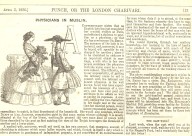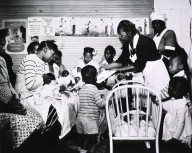
Introduction: As women entered the medical profession, they often concentrated on women's and children's health. This specialization was more acceptable than women treating men, but also women had a vested interest in the health of other women and children going back to women's traditional roles as midwives and family healers. As physicians, women thus continued their tradition of community medicine, performing healing work within the context of social and domestic relationships rather than treating patients and diseases as isolates. In this role, they combined their expertise as trained medical professionals and their cultural roles as moral authorities. In The Laws of Life, Elizabeth Blackwell instructs mothers on the importance of exercise in maintaining their children's health. The cartoon and satirical article "Physicians in Muslin" take Emily Blackwell's completion of the MD as an occasion to poke fun of female doctors. Although Punch was a British periodical, hostile attitudes toward women physicians were similar in the United States. In Doctor Zay, Elizabeth Stuart Phelps, a professional novelist who championed women's entrance into a variety of professions, portrays her physician heroine as a mediator in her community's web of relationships and a promoter of women's and infants' health. She is observed through the eyes of her male patient, Waldo Yorke, who struggles to come to terms with her being a capable doctor who is also a woman.
African American women's commitment to improving abysmal healthcare for African Americans progressed after the Civil War with the establishment of Black medical colleges and professional organizations, as Darlene Clark Hine's essay explains. Yet while more women became doctors, midwives remained key providers of healthcare and education for mothers and children well into the twentieth century—especially in the south. In the photograph by E.S. Powell, nurse-midwife Maude Collen instructs new mothers in a nursery.
Primary:
- Blackwell, Elizabeth. Laws of Life with Special Reference to the Physical Education of Girls. London: Gilbert and Rivington, 1859, Chap. 2. Available on line at http://archive.org/stream/lawslifewithspe00blacgoog#page/n38/mode/2up (accessed 11/26/2012).
- Phelps, Elizabeth Stuart. Doctor Zay: A Novel. New York: The Feminist Press, 1987, Chap. 6-7. Available online at http://archive.org/stream/doctorzay00phelgoog#page/n108/mode/2up (accessed 11/26/2012).
Secondary:
- Hine, Darlene Clark. "Co-Laborers in the Work of the Lord: Nineteenth-Century Black Women Physicians." In "Send Us a Lady Physician": Women Doctors in America, 1835-1920. Edited by Ruth J. Abram. New York and London: W.W. Norton and Co., 1985, 107-120.
Image:
 "Physicians in Muslin." Illustration. Punch, or the London Charivari. April 5, 1856. From Images of History of Medicine database (accessed 11/26/2012).
"Physicians in Muslin." Illustration. Punch, or the London Charivari. April 5, 1856. From Images of History of Medicine database (accessed 11/26/2012). Powell, E.S. "Maude Collen," Photograph. Archives, 1946-76, box 11. From Images of History of Medicine database (accessed 11/26/2012).
Powell, E.S. "Maude Collen," Photograph. Archives, 1946-76, box 11. From Images of History of Medicine database (accessed 11/26/2012).
- For Blackwell: What does Blackwell emphasize in her advice to mothers? How does her advice reflect her beliefs about women's education and women's bodies?
- For "Physicians in Muslin": What does the drawing of the physician (the figure on the right) suggest about popular opinion on the female physician? What are the supposed benefits of women's studying medicine, and how does this tongue-in-cheek article reinforce women's domestic "place"? Why would the caricature of the woman physician not apply equally to a young male doctor?
- For Phelps: How is Dr. Zay characterized? In what ways does Yorke see her as a "typical" woman, and in what ways does she defy gender norms? In what ways is she treating a family or the community rather than just a single patient? Why might Phelps choose this representation rather than a strictly clinical or scientific role for Dr. Zay?
- For "Maude Collen" photograph: What stands out about this scene? How do the women's activities contrast with the women, children, and doctors portrayed on posters for immunization and medical care hanging on the wall in the background? (Think of social aspects of nursing and childrearing, race and gender dynamics in professional medicine advertisements, and the way mothers' bodies are racially coded.)
- For Clark Hine: What advances did African American women make in professional medicine? Why do you think that, overall, their advances came later than those of white women? In what ways do their advances serve African Americans?
Students, singly or in small groups, write 1-2 paragraphs using their research findings, then post the segments in chronological order using an online learning system tool such as a wiki or a document-sharing program. Students identify information that still needs to be found, and compile a collective bibliography of their sources. Optionally, students can prepare annotations ( a sentence or two about each source) for each of their sources in the bibliography.








